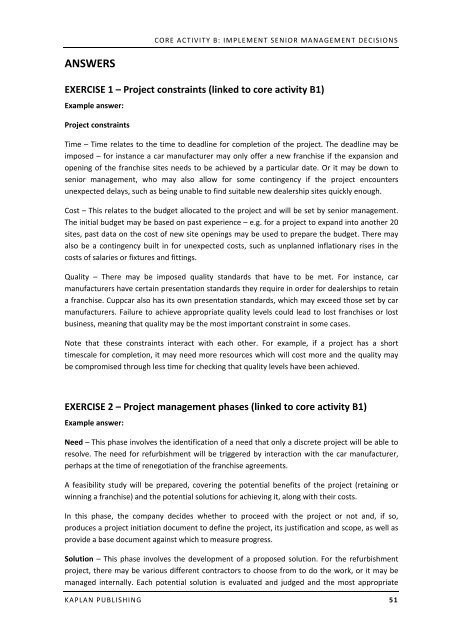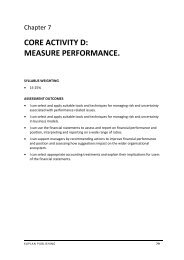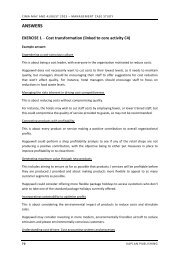CIMA MCS N23F24 - Solutions Activity B
Create successful ePaper yourself
Turn your PDF publications into a flip-book with our unique Google optimized e-Paper software.
CORE ACTIVITY B: IMPLEMENT SENIOR MANAGEMENT DECISIONS<br />
ANSWERS<br />
EXERCISE 1 – Project constraints (linked to core activity B1)<br />
Example answer:<br />
Project constraints<br />
Time – Time relates to the time to deadline for completion of the project. The deadline may be<br />
imposed – for instance a car manufacturer may only offer a new franchise if the expansion and<br />
opening of the franchise sites needs to be achieved by a particular date. Or it may be down to<br />
senior management, who may also allow for some contingency if the project encounters<br />
unexpected delays, such as being unable to find suitable new dealership sites quickly enough.<br />
Cost – This relates to the budget allocated to the project and will be set by senior management.<br />
The initial budget may be based on past experience – e.g. for a project to expand into another 20<br />
sites, past data on the cost of new site openings may be used to prepare the budget. There may<br />
also be a contingency built in for unexpected costs, such as unplanned inflationary rises in the<br />
costs of salaries or fixtures and fittings.<br />
Quality – There may be imposed quality standards that have to be met. For instance, car<br />
manufacturers have certain presentation standards they require in order for dealerships to retain<br />
a franchise. Cuppcar also has its own presentation standards, which may exceed those set by car<br />
manufacturers. Failure to achieve appropriate quality levels could lead to lost franchises or lost<br />
business, meaning that quality may be the most important constraint in some cases.<br />
Note that these constraints interact with each other. For example, if a project has a short<br />
timescale for completion, it may need more resources which will cost more and the quality may<br />
be compromised through less time for checking that quality levels have been achieved.<br />
EXERCISE 2 – Project management phases (linked to core activity B1)<br />
Example answer:<br />
Need – This phase involves the identification of a need that only a discrete project will be able to<br />
resolve. The need for refurbishment will be triggered by interaction with the car manufacturer,<br />
perhaps at the time of renegotiation of the franchise agreements.<br />
A feasibility study will be prepared, covering the potential benefits of the project (retaining or<br />
winning a franchise) and the potential solutions for achieving it, along with their costs.<br />
In this phase, the company decides whether to proceed with the project or not and, if so,<br />
produces a project initiation document to define the project, its justification and scope, as well as<br />
provide a base document against which to measure progress.<br />
Solution – This phase involves the development of a proposed solution. For the refurbishment<br />
project, there may be various different contractors to choose from to do the work, or it may be<br />
managed internally. Each potential solution is evaluated and judged and the most appropriate<br />
KAPLAN PUBLISHING 51
<strong>CIMA</strong> NOVEMBER 2023 AND FEBRUARY 2024 – MANAGEMENT CASE STUDY<br />
solution to satisfy the need is selected. Investment appraisal calculations will form part of this<br />
phase.<br />
Implementation – This phase relates to the actual performance of the project, involving more<br />
detailed planning and implementation of the plans. Monitoring of the project against plan will be<br />
undertaken. For example, there may be a schedule and deadline for each site to be refurbished,<br />
with a budget for each site and for each type of expenditure. It is important to monitor and track<br />
progress against such targets so that timely action can be taken if their achievement starts to slip.<br />
Completion – Once the project is complete, confirmation is needed that the project goals have<br />
been achieved. For instance, failure to achieve the correct quality levels required by the car<br />
manufacturer would represent a significant failure of the project and will detrimentally impact<br />
future revenues and profits. It is also important to conduct a post completion review, so that any<br />
lessons learned from the project can be carried forward to future ones.<br />
EXERCISE 3 – Risk and uncertainty in capital projects (linked to core<br />
activity B3)<br />
Example answer:<br />
Sensitivity analysis<br />
Sensitivity analysis looks at the effect of changing individual variables in an investment appraisal<br />
on the overall value of the project. It can be used to assess which variables are most critical to the<br />
success of the project – the ones that the project result is most sensitive to.<br />
It can be used to analyse how far such variables can change before the project becomes<br />
financially non-viable.<br />
For a project to launch dealerships for a new car brand, variables such as sales volumes will be<br />
especially important to perform a sensitivity analysis on, as the potential for sales will be<br />
unknown in comparison to established brands.<br />
Scenario planning<br />
This allows discrete potential project scenarios to be evaluated separately. Each scenario can have<br />
multiple different variables in relation to the other scenarios, which means that a more realistic<br />
picture of the effect of changing variables, which are often interdependent, can be seen that with<br />
a sensitivity analysis.<br />
For instance, NPVs could be produced under different scenarios such as the new brand being an<br />
immediate success, or gaining market share slowly, or not being successful, could be produced<br />
and evaluated in order to evaluate the risks being faced.<br />
Stress testing<br />
A stress test is a way of analysing a business to consider how well it could cope in difficult<br />
conditions. It would involve, for this project, assessing how well the project can withstand<br />
52 KAPLAN PUBLISHING
CORE ACTIVITY B: IMPLEMENT SENIOR MANAGEMENT DECISIONS<br />
hypothetical detrimental events, such as an unexpected downturn in the market or negative<br />
publicity about the car brand just before the dealerships open. In this context, it would be similar<br />
to scenario planning for negative outcomes.<br />
PRACTICE TASK B1 – Project management (linked to core activity B1)<br />
SUGGESTED SOLUTION<br />
To: Pavarit Chotisin<br />
From: Financial Manager<br />
Date: Today<br />
Subject: Finance project<br />
Need phase<br />
The initial step is to determine the project’s goals and scope. For example, should the finance<br />
company be in a position to provide financing for all car sales at the completion of the project, or<br />
is the intention to start on a smaller scale and build up from that?<br />
Then, a feasibility study will need to be produced, covering Cuppcar’s ability to undertake the<br />
project. This will highlight areas where we may be lacking, such as in financing expertise and<br />
appropriate software.<br />
If the project is considered to be feasible, the project team should be selected such that all<br />
necessary skills are available. As this project is so far removed from our current operations, there<br />
will be a need to source external expertise to be involved with the project team. In fact, the<br />
majority of the project team may need to be experts on financing, as it is such a highly regulated<br />
area. There is no way that the project could be completed without such expertise. A decision will<br />
need to be made whether such people should be contracted or employed to do the work.<br />
The team must be briefed on the project’s goals and priorities. Understanding the objectives will<br />
allow the team to appropriately compare the various options that are open to them in terms of<br />
how to undertake the project.<br />
A project initiation document should be prepared, including such elements as project purpose and<br />
scope, the deliverables, initial budgets, etc. This will give the team something to work to, although<br />
flexibility from these initial parameters will be necessary as the project progresses.<br />
Solution phase<br />
The next stage is to develop a suitable project plan that satisfies the Board’s vision for the project.<br />
The various alternatives that are discussed must be considered in the light of the key deliverables<br />
that have been identified by the Board and all must be fulfilled.<br />
There may be many ways of achieving the Board’s vision for the finance project – for instance,<br />
purchasing an already established finance company or recruiting skilled staff who are able to set<br />
KAPLAN PUBLISHING 53
<strong>CIMA</strong> NOVEMBER 2023 AND FEBRUARY 2024 – MANAGEMENT CASE STUDY<br />
one up from scratch. Each potential solution should be evaluated on both a financial and nonfinancial<br />
basis. Investment appraisals will be produced.<br />
A decision will be made as to which solution to move forward with.<br />
Implementation phase<br />
Once the appropriate solution has been identified, the implementation phase is where it is put<br />
into place. This may involve adaptations to the project team, resources used, budget, etc. as the<br />
project plans become more detailed.<br />
For instance, if it is decided to start a finance company from scratch, more expert staff will need<br />
to be employed who ideally have experience of doing this. If the decision is to purchase a finance<br />
company, the expert staff will already be part of that company and the whole nature and<br />
resourcing needs of the project will change, as well as the budget.<br />
Project management is important at this stage to ensure that the project is progressing to plan<br />
and to highlight areas that are falling behind or that need extra resource allocated to them. It will<br />
also help to monitor the progress of the expenditure on the project and whether extra money<br />
needs to be signed off by the Board in order to complete the project.<br />
Completion phase<br />
At completion, we should implement a post completion review. This will help to ensure that all<br />
deliverables have been achieved, by returning to the goals of the project and checking that they<br />
have been met.<br />
The review will also consider how the project was run and whether there are any lessons that can<br />
be learned from it to use on future projects.<br />
The finance company that has been set up should be integrated into the business. This will require<br />
training of sales staff in particular, so that they understand how to sell the services of the<br />
company.<br />
Financial Manager<br />
54 KAPLAN PUBLISHING
CORE ACTIVITY B: IMPLEMENT SENIOR MANAGEMENT DECISIONS<br />
Trait<br />
Project<br />
management<br />
phases<br />
Level Descriptor Marks<br />
No rewardable material 0<br />
Level 1<br />
Level 2<br />
Level 3<br />
Defines the project phases and gives generic discussion of the<br />
need for management of each, with little reference to the specific<br />
scenario<br />
Defines the project phases and discusses the need for<br />
management at each stage, with some reference to the specific<br />
scenario<br />
Defines the project phases and discusses the need for<br />
management at each stage, with good, justified reference to the<br />
specific scenario<br />
1-5<br />
6-10<br />
11-15<br />
PRACTICE TASK B2 – Risk and uncertainty in capital projects (linked to core<br />
activity B3)<br />
SUGGESTED SOLUTION<br />
To: Pavarit Chotisin<br />
From: Financial manager<br />
Date: Today<br />
Subject: Electric vehicles project evaluation<br />
Expected net present value<br />
Net present values (NPVs) represent the monetary value that would be added to the business if<br />
the project goes ahead and progresses as expected. They tell us the effect on shareholder wealth.<br />
The bigger the NPV, the better the project. On this basis, both projects are financially viable but<br />
the Southshire project would be preferred.<br />
Expected NPVs are NPVs that have been prepared using expected values in the calculations. This<br />
means that estimates of future outcomes have been made, along with the anticipated<br />
probabilities of them happening and then a long-term average figure for the outcome has been<br />
calculated. In these calculations, an expected level of sales volumes has been used.<br />
The use of EVs takes risk into account, in that it uses all possible outcomes in its calculation, but it<br />
hides the level of risk that is faced by showing only an average figure. For instance, we cannot see<br />
the values for the lowest and highest level of cars sold for each project, which would give us an<br />
idea of the possible spread of potential NPVs and therefore the risk we face.<br />
KAPLAN PUBLISHING 55
<strong>CIMA</strong> NOVEMBER 2023 AND FEBRUARY 2024 – MANAGEMENT CASE STUDY<br />
The results are highly dependent on the assumptions and the probabilities used in the<br />
calculations. There needs to be a reasonable basis for the figures used to give the results meaning.<br />
The use of expected values is most appropriate when a decision is repeated over and again, so the<br />
overall results tend towards the average. For a one-off decision, they may not be appropriate. For<br />
this situation, if the initial project is successful, it may indeed be repeated across other counties in<br />
Welland. This means that the use of EVs may be appropriate, although it does not take into<br />
account regional differences if the project is replicated across the country.<br />
Standard deviation of expected NPV<br />
The standard deviation of expected NPV does give us an indication of risk. Standard deviations tell<br />
us how far on average the possible outcomes of the project are from the mean, or expected NPV.<br />
They therefore give us an indication of the spread of outcomes and therefore the risk.<br />
We can see that the standard deviation for the Southshire project is much bigger than that of the<br />
Northshire one. This means that the Northshire project is likely (approximately a 68% chance if<br />
the results are normally distributed) to give an NPV of between W$200 and W$220 million,<br />
whereas the Southshire project is likely to give a spread of W$200 to W$300 million. The<br />
Northshire project is therefore less risky, but given that the low end of the spread for the<br />
Southshire project is the same as the Northshire project, the higher risk of the Southshire project<br />
should not unduly worry the Board. Both projects are still likely to produce highly positive NPVs<br />
after the risk as illustrated by the standard deviation has been taken into account.<br />
Sensitivity figures<br />
Sensitivity analysis tells us how far a variable in question would need to change before we would<br />
change our mind about going ahead with a project. In other words, the presented figures show us<br />
by how far the sales price, capital investment costs and sales volumes would need to individually<br />
change before the projects became financially non-viable.<br />
The lower the sensitivity figure for a variable, the more sensitive the project outcome is to a<br />
change in that variable.<br />
We can see that the capital investment would have to increase by 15.3% for the Northshire<br />
project and 12.5% for the Southshire one before each project is no longer beneficial to undertake.<br />
These figures are relatively large and should not cause us much concern, unless we feel that<br />
changes of this size are possible.<br />
The sales price sensitivity figures are similarly quite high and should not cause us much concern.<br />
The sales volume sensitivity figures are lower and therefore a little more concerning, more so for<br />
the Southshire project where volumes only have to fall by 3.4% before the project becomes nonfinancially<br />
viable.<br />
This factor is made even more concerning when we consider that the sales volumes used in the<br />
appraisals are expected value figures, meaning that there is a genuine potential for sales volumes<br />
to be lower than the value used in the appraisals. Sales volume figures represent the main area of<br />
risk in relation to both projects.<br />
56 KAPLAN PUBLISHING
CORE ACTIVITY B: IMPLEMENT SENIOR MANAGEMENT DECISIONS<br />
Further investigation should be made in relation to sales volumes, in order to further evaluate the<br />
project risk levels before a decision is made.<br />
Financial Manager<br />
Note: the detail of normal distribution probabilities is not necessary, but a general understanding<br />
of standard deviations may be useful, in that the lower the number, the closer the potential<br />
individual outcomes are to the expected value.<br />
Trait<br />
Project<br />
evaluation<br />
Level Descriptor Marks<br />
No rewardable material 0<br />
Level 1<br />
Level 2<br />
Level 3<br />
Offers generic discussion of the figures and minimal reference to<br />
risk, with little application to the specific Cuppcar scenario.<br />
Offers good discussion of the figures with some reference to<br />
risk, with good reference to the specific Cuppcar scenario.<br />
Offers full discussion of the figures and refers to risk throughout.<br />
Discussion is centred on the specific Cuppcar scenario.<br />
1-5<br />
6-10<br />
11-15<br />
PRACTICE TASK B3 – Financing sources (linked to core activity B4)<br />
SUGGESTED SOLUTION<br />
To: Pavarit Chotisin<br />
From: Financial Manager<br />
Date: Today<br />
Subject: Financing of flagship dealership<br />
Hi Pavarit,<br />
Bond finance<br />
The fixed rate bond offers lenders security, which should result in a relatively low cost. In the<br />
event of insolvency, bondholders would rank ahead of equity shareholders for repayment of their<br />
investment. Also, the finance cost is a predicable cash outflow and is a tax-deductible expense<br />
against profits. Cuppcar also has ownership of dealership premises around the country, the value<br />
of which significantly outweighs the current loan balance, so these premises could be used as<br />
security for the finance raised.<br />
Only the coupon (interest) is payable each year and the principal (the amount borrowed) is not<br />
due to be repaid until 2026. Therefore, from a cash flow point of view, it gives time for the<br />
investment to start earning returns before we need to repay the amount borrowed. However, we<br />
KAPLAN PUBLISHING 57
<strong>CIMA</strong> NOVEMBER 2023 AND FEBRUARY 2024 – MANAGEMENT CASE STUDY<br />
need to clarify the expected payback period and compare this with expected cash inflows arising<br />
from the investment. Cash flow issues may occur if the investment hasn’t yet paid back the<br />
amount invested in it by the time we need to pay back the debt.<br />
Cuppcar’s gearing will increase with the issue of the bond. This increases the financial risk of<br />
Cuppcar because it will run into difficulties if it cannot service the bond’s cash flows. Given that<br />
the current level of gearing is approximately 22%, it is unlikely to adversely impact on the group’s<br />
ability to obtain additional finance.<br />
Rights issue<br />
Rights issues are generally an attractive means of raising equity. Shareholders can either increase<br />
their shareholding or sell their rights. Shares will normally be issued at a premium, but at less than<br />
their current market value to encourage existing shareholders to take up the rights issue.<br />
A rights issue will decrease financial risk by raising equity and therefore reducing gearing,<br />
although it will not significantly affect the ratio in this case.<br />
The amount required in this case is relatively small and so it may not be cost-effective to make a<br />
rights issue. There are significant expenses associated with making a rights issue, such as<br />
professional fees, particularly for a quoted company. Those expenses bear little relationship to<br />
the amount being raised.<br />
The potential for the need for future investment would also make a rights issue less suitable. If<br />
the flagship dealership is viewed as a success by Barto Motors, they will likely wish to repeat it<br />
across other dealerships. To repeat the time and disproportionate expense of issuing new shares<br />
for multiple similar projects would not be an efficient way of raising finance. The repeated request<br />
for investment may therefore be viewed negatively, particularly by our shareholders.<br />
Financial manager<br />
Trait<br />
Bond and<br />
rights issue<br />
advantages and<br />
disadvantages.<br />
Level Descriptor Max Marks<br />
Level 1<br />
Level 2<br />
Level 3<br />
No rewardable material 0<br />
Identifies some advantages and disadvantages, with<br />
little application to the specific scenario.<br />
Offers a clear discussion of the advantages and<br />
disadvantages of the bond issue and rights issue,<br />
with some application to the specific scenario.<br />
Offers a clear and comprehensive discussion of<br />
using the advantages and disadvantages of the<br />
bond and rights issue, with the discussion fully<br />
applied to the specific scenario.<br />
1-5<br />
6-10<br />
11-15<br />
58 KAPLAN PUBLISHING

















